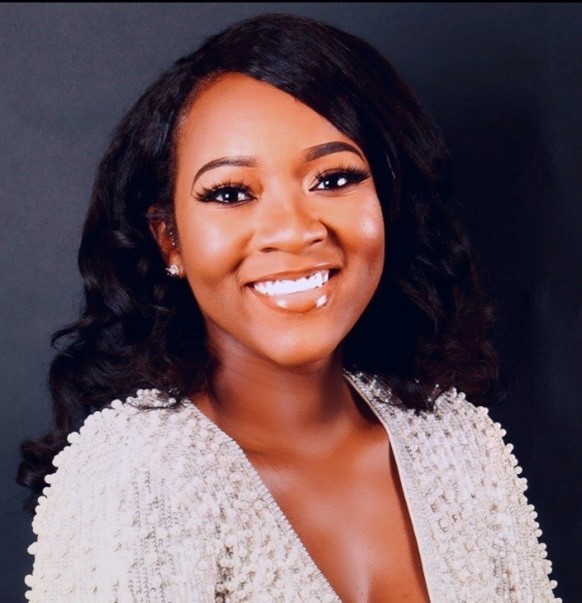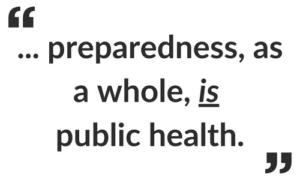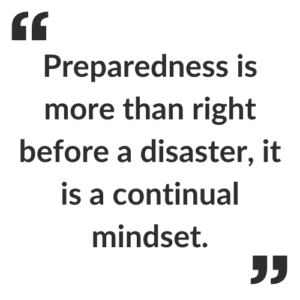Public Health Thank You Day Interview Series: Alexandra Harris, Emergency Management Specialist

In honor of Public Health Thank You Day, Research!America is putting a spotlight on public health professionals who are working to mitigate disasters, prevent disease, and advocate for public health legislation that results in equitable health solutions for communities across the country.
Alexandra Harris, MS, MPH, Emergency Management Specialist for the Office of Emergency Management, Prince George’s County Office of Homeland Security, shares her journey into the field of public health and discusses how emergency management plays a critical role in the intersectionality of preparedness and public health.
How did you become interested in public health?
When I was a young child, I grew up in areas that were lower income, where health was an afterthought – so I wanted to be a physician. While I was at Xavier University of Louisiana, I realized that I didn’t enjoy the “hands-on” parts of health. So, I began to study sociology, which is where I was first introduced to the field of public health. I was able to see the social and medical aspects of the field … and I think to this day that helps me integrate a holistic view of health and public health.
What does it mean to be an emergency management specialist?
I was the wild card and the long-shot hire for emergency management. I had to show the connection between public health, preparedness, and emergency management in interviews. Now, I integrate both emergency management and public health. My title spans the gamut from working in the emergency operations center (EOC), [being] out in the community, [and] managing communications. I do a little bit of everything and am responsible for emerging issues and projects. This is where I typically integrate public health.
Emergency management has been previously response-based and tends to be people with a first responder background (former police, firefighters, EMS, military, etc.). With that siloed mindset, before the pandemic, the field had very little interaction with the health department and very little understanding of public health preparedness.
What is a typical day for you?
On a typical day, I’ll review a proposal since a lot of our work is through grants from FEMA. [With Prince George’s County, MD, being right outside of DC], we have an urban area security initiative (UASI), so that money is funneled into larger bases to prepare for, respond to, and mitigate disasters. In addition to the proposals, I spend time maintaining grants, doing documentation, and applying or looking for new innovative solutions.
Recently, we’ve worked with partners like the Department of Environment on climate taskforce activities and the Prince George’s County Health Department on pandemic and monkeypox response work – which is all very active still. We work with the county executive office to make sure we maintain continuity of operations (COOP) and make sure that the critical functions of the government are still operational in an emergency. COOP’s value became evident during the pandemic, when people were no longer able to work at their full capacity.
How has your role and the role of public health changed over the course of the COVID-19 pandemic?

Prior to the pandemic, the interaction between emergency management and public health sat in the hands of our communications or outreach efforts. We ensured that the information we released was culturally competent, in the right languages, and in the right font size to make sure everyone – especially hard to reach communities – was receiving our messages.
Now, the pandemic has highlighted the fact that we need to be more integrated and understand how it all works together. As the responding agency, we were thrown into public health situations [more than ever before] or [planned for], and we needed to work collaboratively with the health department (who don’t regularly respond to disasters or have the processes to do so). While they were the subject matter experts on the virus, we took the lead by deploying systems, setting up camps, and more. It opened the door for understanding how the many things we do in a disaster translate to a long-term emergency. We’ve been able to bridge a gap that has always been there.
How do you build trust/maintain relationships with the different groups and people you work with?
Most of our work is with other government entities. I work as liaison between the county and local municipalities – with the mayors, public works, emergency management, and others to make sure we’re all on the same page and to make sure the county can fill the gaps. With those relationships, we stay in constant communication on a monthly basis to keep that channel open. When something does happen, we’ll inform them of the current status of an emergency and where they can find resources. I also work with community-specific liaisons (Latino Affairs, African Diaspora Affairs, Veteran Affairs) to ensure our emergency information is passed on to those communities.
In a more limited capacity, we do work with nonprofits on an actual response or in preparation for a response. We’ll work with a group like the Red Cross or United Way as we prepare and say, “Here is our role, here is your role.”
Do you incorporate a health equity approach or specific initiatives that advance health equity? If so, how?
I started by incorporating equity in small drops to show my colleagues that it exists. Currently, health equity is incorporated at the planning aspect. I explained that the social determinants of health are things that we address every day from an emergency management perspective: built environment, lack of food, and more.
We’re working on an initiative called Resilience Hubs, which is a FEMA-based initiative based in the understanding that response happens at the community level. These hubs are a place to bring in public health, social services, and other entities that have operated on their own but can come together to protect the community’s health and safety. They are safe physical spaces in the community to get information about preparedness or physically convene during a disaster to chart a path forward. Resilience hubs rely heavily on public-private partnerships – so a hub might be a local church or other trusted place in the community.

We also think about equity with flooding – the greatest hazard in our area. In working with our Department of Environment, we’re always keeping an eye out for equity amongst neighborhoods in flood insurance, in people making claims, in real-time responses, and in prevention.
Where do you see the greatest need for improvements?
Awareness of public health and emergency preparedness is still the greatest weakness. It’s easy for everyone to care in the middle of an emergency, while it’s still [happening], but in the time between one emergency ending and the next starting, relationships and communications fall off. We even saw it when we thought COVID was dying down last year.
But we’ve realized, when we’ve had to ramp back up, that we shouldn’t have closed those doors quite yet – and those doors should never close. Communication and collaboration have to continue beyond this pandemic and through the next one.
The public prior to the pandemic knew almost nothing about emergency management. It’s important to understand that preparedness, as a whole, is public health. Those who are most disadvantaged before disaster hits end up in a more compromised state and find their health more affected than others. Small steps towards preparedness will pay off.
What role can the public play to strengthen the future of public health? What do you want the public to know?
Preparedness is more than right before a disaster, it is a continual mindset, and disasters strike with no warning. With climate change, [disasters] are happening more frequently and with more intensity. You might not know exactly how the next disaster will strike but it will – so it’s worthwhile to do the small things in advance.
- If you see canned food on sale, grab a few extra.
- Set cash aside over time so you’re ready when ATMs are down.
- Have a generator on hand with some fuel – it’s truly a way to buy your household time in an emergency.
- Be sure to regularly check in with your family monthly to make sure everyone is on the same page:
- Do you have a plan?
- Do you know everyone’s phone number?
- Do you know how you will communicate and congregate once something happens?
Is there anything about your job or field that you wish more people understood or anything else you would like to mention that we didn’t cover?
Prepare, prepare, prepare! The government cannot come and save everyone. We rely on people and families being prepared, so that we can address the folks who are the most impacted.




